BMX BIKES GUIDE
BMX bikes are designed for one reason - fun. The way in which riders enjoy this exciting discipline relies on technical expertise, competition and lifestyle. The bicycles come in several frame sizes depending on the intended use, with 20" wheels and a variety of components and accessories enabling the rider to pull off all sorts of stunts.

A Brief History
This sport has been around since the late 70s originating in California, USA and stands for "Bicycle Moto Cross (X)". BMX riding became hugely popular in the 1980s and many believe that this is where mountain biking originated from. However, it has managed to remain unique with a culture and lifestyle of its own. Incredibly popular but still independent of the main stream, BMX has branched off into many disciplines. Some styles remain firmly in the domain of the few trendsetters while other areas, such as racing have been officially recognised by the Olympic committee and have been awarded full status at the Olympic Games.
An Introduction To BMX Riding
BMX riding has five main disciplines that are split into two sections; racing and freestyle. Four of the areas come under the general heading of freestyle riding, which all have their own style, tricks and culture. These disciplines are Flatland, Dirt Street, Ramp and Park. All BMX riding is strongly influenced by riders who have paved the way for others to follow, such as Bob Haro, Ron Wilkerson, Eddie Roman and Matt Hoffman who push the boundaries of the sport creating new tricks and constantly developing the sport. These riders lead the way in bike design and fashion with large manufacturers stepping in and using their knowledge to design new signature brands and models that are used in skate parks, on the street and raced around tracks across the world. However, BMX is not just about riding. It's about a way of life with a unique style that is now spreading to other areas of cycling as well as main stream fashion and culture.
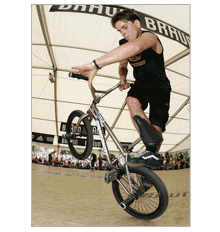
Flatland BMX
The basic idea behind flatland riding is performing tricks whilst riding on a flat piece of land. This makes it highly accessible to riders as it does not require obstacles or specially built parks. As with all BMX disciplines a high level of skill and lots of practice is required with groups of riders often gathering in car parks or tennis courts to show off their moves. The cycles tend to be short and light, giving the rider to have greater control and allowing the fames to be spun more easily. For optimum positioning at either end these bicycles have four stunt pegs (two on each wheel) and generally use a gyro headset that enables the bike to be spun 360 degrees without tangling the cables. Most BMX riders will also use two brakes at the front and rear, however this is personal choice as many prefer a simple front brake.
Dirt Jumping
Dirt jumping takes place on either a collection of jumps (otherwise known as trails) or on one or two larger jumps. This discipline is the most common type of BMX competition seen on the TV in popular events such as the X-games. Trail riders often build trials in woodland with systems of jumps that all link together and larger ones mixed in so that the biker can pull different styles and ranges of tricks from one jump to the next. Dirt Jumping involves large jumps where big air is the name of the game. Lots of tricks can be dangerous and extremely difficult to perform. BMX bikes are heavier than street or flatland cycles, made from strong steels and often triple butted welding at the joints. This is essential as they need to be manufactured to withstand the large impacts that this skillful discipline involves. They will normally have no stunt pegs and will only feature a gyro if that is the type of trick the rider wishes to perform. The wheels, although still 20", commonly have just 36 spokes. Although strong they are lighter and easier for jumping and moving in the air. The bars are two piece for added strength and incorporate a bracing bar to stop them collapsing upon landing. Tricks include back flips, tail whips and 360s.
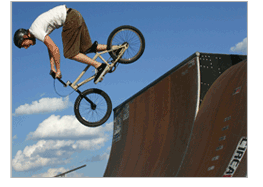
Ramp & Park Cycling
This discipline requires a specially designed ramp park which can be made of concrete, wood or aluminium (which are less common). Most local authorities have created skate and bike parks after coming under pressure from the riders who argue that purpose-built parks keep them off the streets and allow them to ride in relative safety on specially designed equipment. Bicycles for vert ramps are essentially the same as those used for street riding with a range of tricks that are similar to dirt jump, including Flares, 180 back flips and 50-50 grinds on the pegs.
Street Riding
As the name suggests, this kind of riding takes place around the streets using road furniture such as ramps, benches, walls, rails and pretty much anything else that is fair game to pull tricks and jump off. The bikes need to be very robust in order to cope with the abuse that they are routinely put through. Originally these cycles were very heavy, with over engineered steel frames, however, improvements in the metals and production techniques combined with the growth of the sport means that manufacturers are now willing to spend money in development. The bicycles normally come fully geared up with the maximum options to pull whichever tricks present themselves from a particular obstacle. Most models will normally only carry one brake at either the front or rear depending on how the rider likes it. Tricks include bar spins, 50-50 grinds on the pegs and ice picks.
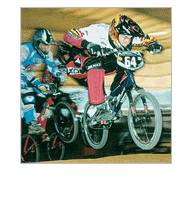 BMX Racing
BMX Racing
BMX racing originates from motocross and shares many similarities, including the type of tracks used. The main differences is that they are shorter (normally 200-300metres) and generally smoother. Races last around 25-40 seconds, with speeds of up to 35 mph depending on the track and riding conditions. The bikers race for points and the competitor with the most points at the end of a meeting, championships or season is declared the champion. Now an Olympic sport it has seen a huge growth in both popularity and bike design with many of the same materials and frame technologies being taken from MTB racing and road racing. The goal is to have a light, stiff, responsive, good handling and most of all a fast bicycle. These designs will have no accessories such as pegs and giro headsets and the wheels will be light with fast rolling tyres to propel the rider across the line in first place.
How To Buy A BMX Bicycle
You can buy a BMX Cycle either as a production bike or a custom built model:
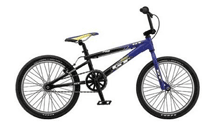 Production BMX Bikes
Production BMX Bikes
Sold as a complete package (frame, chainset, wheels, handlebars, saddle / seat post, grips, chains) this variety usually represents great value for money. You can still customise the stem length, crank length and saddle position. For all types of BMX, prices start at around £120 for a basic model up to around £450 for a lightweight cromo (steel alloy) framed bike with top quality components.
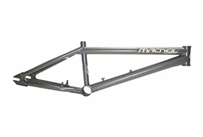 Custom Built
Custom Built
These bikes are the ultimate in flexibility. You can choose individual specialist components, for example the chainset, wheels, handlebars and the type or number of brakes which suit you best. For a frame set you can expect to pay anything from £100 for a standard frame rising to £400 for a state of the art lightweight racing frame. From there you can spend as much as you budget allows to create the ultimate personalised machine. BMX framesets do not come with a fork so this will also need to be selected to suit your frame and intended use.
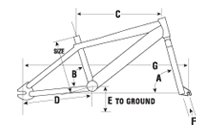
Bike Fitting
BMX bicycles come with standard 20" wheels and frame sizes depending on the type of riding you are doing. Lower end bicycles tend to come with a 12" seat tube and a top tube measuring around 18". This is because they are not necessarily designed for a specific use but have a standard frame with added accessories to enable them to be used in different disciplines. As the price increases, the models become even more specialised, using a 12" seat tube but differing in the length of top tube.
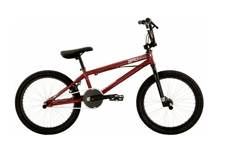
Bike Sizing
When choosing your new BMX cycle it is extremely important that you pick the correct size to suit your chosen discipline. For street, ramp and dirt jumping the most popular size of frame is a 21" top tube. This will give the rider the best feel and room to swing the bike underneath without getting tangled in the handlebars or saddle.
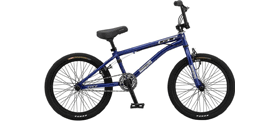
For the specialist discipline of flatland riding, designs will tend to be shorter in the top tube, typically around 20" or below. This enables the rider to have greater control so they can use either end of the bike and stunt pegs to perform the incredible tricks of balance and skill that are at the heart of the sport.
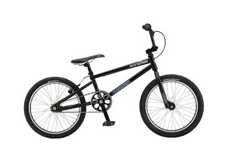
The whole idea behind the frame size and geometry on a race BMX is to enable the rider to get into the most comfortable and powerful position on the bike to achieve the highest speed. For this reason the length of the top tube is dependent on the size of the cyclist and much like road racing the fit is more important. This is why contrary to the freestyle disciplines frame builders produce designs in various top tube sizes. An extensive choice is provided in order to achieve the correct fit. For this reason, custom building of the frames and components is very popular amongst racing cyclists.
BMX Buying Checklist
With the extraordinary range of bikes and components available it can be very confusing knowing what to look out for when buying a BMX to suit your specific needs. Our quick checklist should give you all the help you need!
The Frame
Freestyle or Jump Bikes.
These require a very strong and sturdy frame, normally made out of steel with strong welds. It must be able to withstand the constant abuse that this discipline involves.
BMX Race
These have extremely lightweight frames that can be half the weight of a jump frame. These models are often made of lightweight CroMoly steel or aluminium and some manufacturers are even producing carbon frames.
Wheels
BMX Race
These lightweight aluminium wheels are made with around 32 spokes built around stiff fast rolling hubs.
Freestyle (flatland / street)
Made with around 48 spokes and constructed for stiffness and stability.
Jump
These are made from 36 stiff and strong 13-gauge spokes. The aim is to be light enough in the air but able to withstand the impact of a hard landing.
Tyres
All BMX wheels feature a clincher tyre. This design uses inner tubes inside that inflate to hold a beading on the tyres edge onto a lip on the rim. When punctured, the tube can be easily replaced with a compatible 20" tube instead of having to replace the entire thing.
BMX Race
These tyres have enough tread to provide excellent grip. The patterns are made to offer low rolling resistance to get the bike up to speed and keep it there. This type is typically about 1.75 inch in width.
Freestyle (flatland & street)
For a more stable base the tyres will be wider at around 2.1 inch. They feature a smooth tread designed to run on pavements and hard surfaces.
Jump
These tyres need to offer good traction and typically bikes will run a wide 2.2" tyre on the front and a 2" tyre on the rear. Although knobbly tyres will give good traction many riders choose to safeguard the dirt jumps that they have spent days building and use more forgiving rounded tread tyres.
Brakes
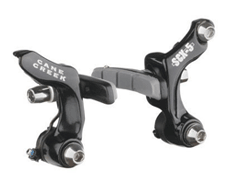
Freestyle Bikes
In general these bicycles have gyro (non tangling headsets) so that the handlebars can be swung 360 degrees without tangling the cables.
BMX Race
They will normally run linear pull rear brakes only which give great control and power for stopping suddenly.
Freestyle
These cycles can run front and rear U- brakes which are preferred for modulation rather than extreme stopping power. However, this is dependent on the style and type of riding performed. It is important to note that if using the bikes on a public highway they must be equipped with at least one brake.
Jump
Jump bikes typically use a single rear U-Brake that enables the rider to control their speed in and out of the jumps. Having a front brake can be dangerous as if it is pressed by mistake (for instance when landing a jump) the cyclist will lock the front wheel and inadvertently be catapulted over the bars.
Handlebars
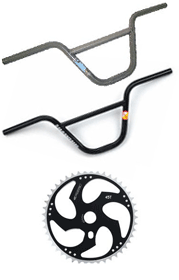
Freestyle / Jump
For all of the freestyle disciplines the bikes will use steep riser bars which give good feedback and control whilst jumping and pulling tricks.
Race BMX
These cycles use handlebars that are upright with crossbars to provide extra strength. Additional padding is also routinely used to prevent injury when crashing.
Gearing
With BMX cycles using single speeds the biker has to make sure that the correct gear ratio is selected in order to perform tricks or compete in races. Here is a general guide to the types of gearing that riders will use for each discipline.
Street
The cranks will be between 165mm and 175mm depending on height of the rider and bottom bracket clearance depends on the type of tricks being pulled. The gearing tends to be 'micro gearing' which means that to achieve the desired gear ratios the bikes will have eight teeth on the rear sprocket and 25 teeth on the chainring. This enables shorter chains and better clearance over obstacles for the chainset. The cycles will often be equipped with chain tensioners to prevent the chains from shipping (falling off) during jumps and tricks.
Flatland
They use micro gearing and will tend to use free-coaster rear hubs that mean if the bike rolls backwards the chain and hub will not move with it.
Jump
Typically jump riders will use 36 teeth on the chainring and 16 teeth on the rear sprocket to obtain the correct amount of acceleration required to get in the air.
Race
Gearing is very dependent on the nature of the course but typically on a fast course riders will use 36-38 teeth on the chainring and 16-18 teeth on the rear sprocket. This is combined with long cranks of around 175mm for good leverage.
On a standard complete model the manufacturers will include a gearing of 36 teeth on the chainring and 16 teeth on the sprocket. This will give an all purpose ratio for many kinds of riding.
Protective Gear
Helmets
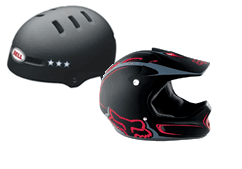
These are a vital part of any riding as they provide valuable protection when the inevitable happens and you fall off. Unlike other areas of cycling, helmets are part of the culture of the BMX scene and it is very rare to see a rider at a skate park without one. The two main styles are full face (which racers prefer) and mullets (piss pots) which are most commonly found in the freestyle disciplines. The crash helmets start at around £30 and rise for a full face helmet to £150.
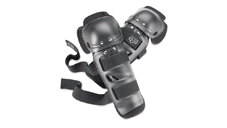
Knee & Elbow pads
Just as with helmets protection for your knees and elbows is part and parcel of riding both in a style and cultural sense, as well as for safety purposes. Pads are specifically designed for BMX and jump bikes and start at around £15 rising to £40 for more advanced designs.
Gloves
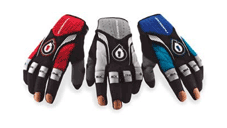
Protecting you hands and skin when crashing and to give added grip on the bars makes gloves and mitts another essential. All come with padding on the palm and can either be purchased as mitts (short finger) or full finger. The amount of knuckle padding and Kevlar protection varies and you can expect to pay anything from £10 up to £50.
Apparel
Due to the nature of all BMX riding disciplines sooner or later you will fall off, which is why your choice of clothing is all important. Many riders wear long shorts or jeans and long or 3/4 sleeve tops that (when worn over pads) provide a good level of protection. Style is everything in BMX riding and around the sport a huge fashion industry has grown using the top riders to advertise their ranges. The correct name on a top or pair of trousers can be just as important as how well you ride.
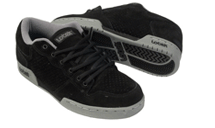
Shoes
As the riders are not clipped into the pedals as in other areas of cycling, no special shoes need to be worn. However, many shoe companies produce strong soles and hard wearing uppers in trainers that are styled and designed to be used on a BMX. These can add to the riding experience and give the cyclist the correct look.

